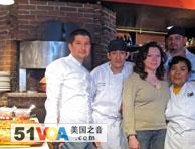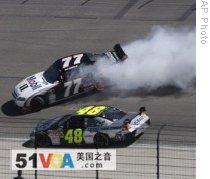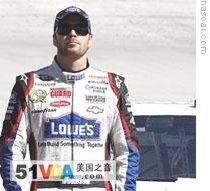2009-4-9
Welcome to AMERICAN MOSAIC in VOA Special English.
(MUSIC)
I'm Doug Johnson. This week:
We hear music by the Irish rock band U2 ...
Answer a listener question about stock car racing ...
And report about a restaurant in Washington, D.C. that operates a fully "green" business.
(MUSIC)
Coppi's Italian Restaurant
HOST:
More and more restaurants across the United States are starting to cook with organic fruits and vegetables. Organic foods are grown without chemical fertilizers and insecticides. But one restaurant in Washington, D.C. has gone far beyond just buying organic food in its effort to be sustainable and healthy. Coppi's restaurant on U Street has become a good example in the community of how to operate a "green" business. Bob Doughty has more.
BOB DOUGHTY:
When you walk into Coppi's Italian restaurant, it looks like many other warm and lively eating places on the popular U Street corridor.
 |
| Carlos Amaya, left, with his team at Coppi's |
CARLOS AMAYA: "Coppi's is a very unique, sustainable restaurant. The theme of it is of course, northern Italian, but the difference in maintaining a sustainable restaurant, meaning we have to source American products."
Almost all of the salads, pizzas, meats and pastas served at Coppi's are organic. Mister Amaya buys seasonal foods from local producers who follow sustainable practices.
CARLOS AMAYA: "We've actually visited these farms to see exactly where everything comes from and the process, so you can understand it and explain it better to the clientele."
Mister Amaya even buys the flour for his pastas from an American producer so that he does not have to import flour from as far away as Italy.
Also, all the electricity used at Coppi's is wind-generated so it does not cause pollution. And, all cooking in the kitchen is done with only two hot water boilers for pasta and a wood-burning oven. Most restaurants use large gas ovens and stoves which can be wasteful. The oak wood for the oven comes from an organic farm in Pennsylvania that collects old wood from fallen trees.
Other details are important to Coppi's green efforts. For example, the restaurant has very low lighting to conserve energy. And, the restaurant saves on water and energy by not using tablecloths.
Carlos Amaya was born in El Salvador. He started working at Coppi's in nineteen ninety-four. Over the years he worked many different positions in the restaurant. In two thousand two, he bought the restaurant from its owners.
CARLOS AMAYA: "By then, I had already developed my own idea of what sustainable was, and where it needed to go."
The former owners were interested in organic cooking. But Carlos Amaya knew he wanted to make the business even greener. He says that owning Coppi's is a good example of the American Dream.
CARLOS AMAYA: "Here I am, and the unique thing about the United States and the American way of living is we have rights to own our own businesses and to actually lead by example."
Coppi's owners and visitors can feel good about the food they are making and eating because it is delicious, healthful and sustainably produced.
(MUSIC)
NASCAR
HOST:
Our listener question this week comes from Brazil. Anderlon Rocha de Oliveira loves the sport of NASCAR. He wants to know about this season's Sprint Cup.
 |
| Sam Hornish Junior (77) slides in front of Jimmie Johnson (48) during the NASCAR Samsung 500 race at Texas Motor Speedway in Fort Worth on April 5 |
Stock cars used to be produced in car factories. They were not specially designed for racing.
But now most stock cars are individually designed and built, although they still look like cars you see on the road. The power from the engine pushes the car forward from the back wheels instead of pulling it forward with the front wheels.
NASCAR races generally use oval shaped tracks of different lengths that require turns to the left. There are short tracks, longer tracks called speedways and even longer ones called super-speedways. There are also some races on tracks called road courses. These require right and left turns.
The Sprint Cup uses all these kinds of tracks. It is the highest level of competition and most popular of all NASCAR series. People often use the words Sprint Cup and NASCAR as if they were the same thing.
The ten month thirty-six race Sprint Series began in February in Daytona Beach, Florida. The Daytona Five Hundred race is one of the most famous races of all. The drivers race around the super-speedway two hundred times to travel about eight hundred kilometers in all.
 |
| Jimmie Johnson |
Right now, Jeff Gordon is in first place in the Sprint Cup series. His victory Sunday at Texas Motor Speedway in Fort Worth was especially sweet. It followed forty-seven winless races. Jeff Gordon is a four-time Sprint Cup champion.
But hot on his racing trail is Jimmie Johnson. Last year, Johnson became the second driver in history to win a third straight Sprint Cup championship. And close behind Johnson is Kurt Busch. He won the Sprint Cup in two thousand four. All three top racers will compete at the next Sprint Cup race April eighteenth in Phoenix, Arizona.
(MUSIC)
U2
HOST:
The Irish rock group U2 has been making music for over thirty years. Their latest album, "No Line on the Horizon," is filled with poetic songs about love, separation and the human condition. The group explores many different musical styles in this album. Shirley Griffith tells us more.
 |
| U2 |
SHIRLEY GRIFFITH:
That was the song "Magnificent." Like many of U2's songs, it is an expressive love song with a melody that is hard to forget. The album "No Line on the Horizon" took the band about two years to complete. They first started testing out songs together while on a trip to Fez, Morocco.
U2 lead singer Bono said he did not know how fans would react to the record.
But he said being comfortable and predictable by recording the same kind of music is not the place for rock music.
The energetic "Get On Your Boots" is one of the fastest paced songs U2 has ever recorded. The song starts with these words: "The future needs a big kiss". Bono has said that the hopeful message of this song is especially meaningful during these difficult times.
(MUSIC)
Starting this summer, U2 will perform around the world on its 360 Degrees Tour. A huge structure with four legs is being built as the stage for the tour. It will permit the band to perform surrounded by the audience. And, U2's manager says the band has worked hard to make sure tickets are lower in cost than in the past so that fans can afford to attend the shows.
We leave you with the smooth sound of "Moment of Surrender."
(MUSIC)
HOST:
I'm Doug Johnson. I hope you enjoyed our program today.
It was written by Caty Weaver and Dana Demange who was also the producer. Join us again next week for AMERICAN MOSAIC, VOA's radio magazine in Special English.